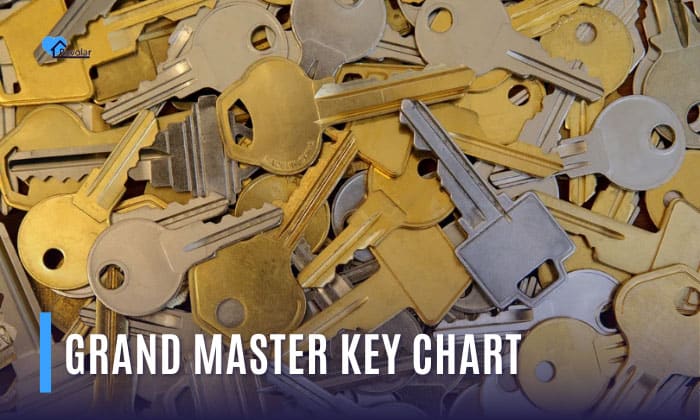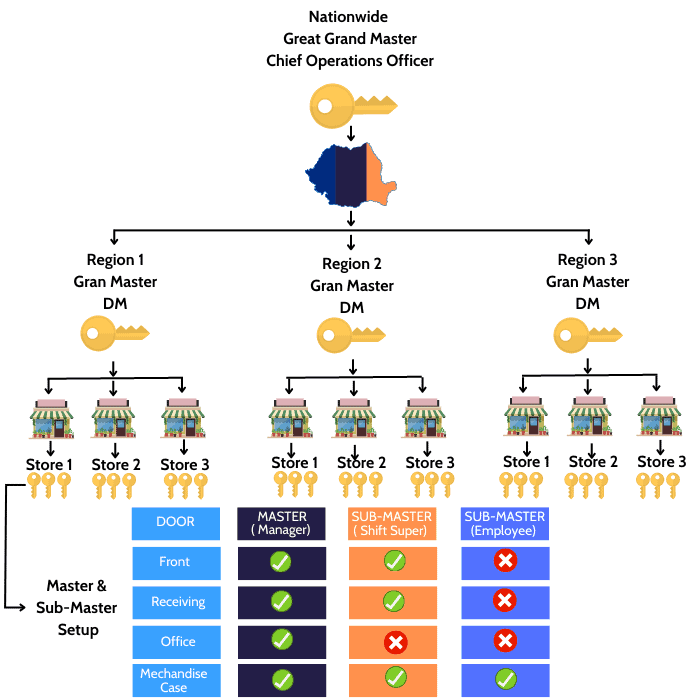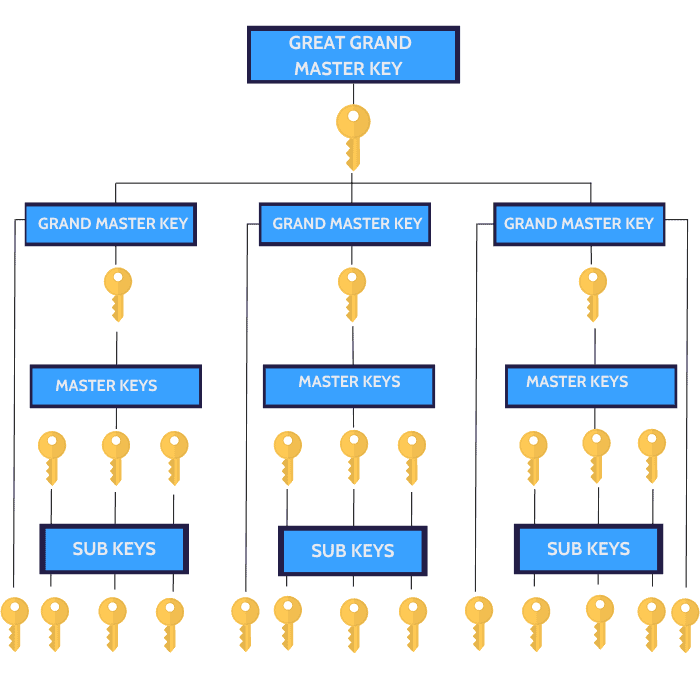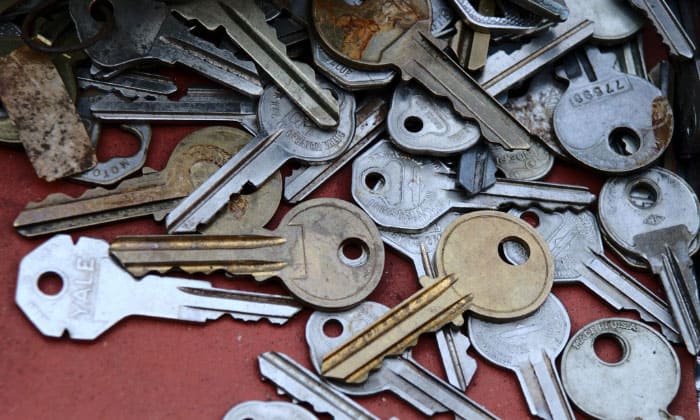
As a residential building owner or a property manager, keeping the property and its residents safe should be your number one priority. This requires a thorough understanding of the building layout, its weak spots, as well as the hierarchy of the keying system.
A grand master key chart provides a comprehensive overview of the property’s keying system. It specifies the level of access that each key has, displaying their relationships in a clear visual presentation.
Want to learn more about this fundamental key chart? Keep on scrolling!
Table of Contents
Understanding the Grand Master Key Chart

The origin of mechanical locks dates back thousands of years, with evidence of locking mechanisms found in ancient civilizations such as Egypt and Assyria.
As buildings grew larger and more complex, the need for higher levels of key hierarchy developed. Then came the Grand Master Key System, where a single key, known as the Grand Master Key, could provide access to all locks within the system.
To keep track of which key goes where and the hierarchy of the keys, locksmiths came up with the grand master key chart.
A grand master key chart, also known as a Grand Master Key System or a Master Key Hierarchy Chart, documents the relationships between different keys in a keying system.
Buildings, facilities, or organizations that require controlled access to specific areas or rooms commonly use a key chart. Such properties often have multiple levels of keys, each providing different levels of access. The grand master key chart helps visualize this hierarchy.
The typical layers of keys in a keying system are:
- Grand Master Key: The highest level of key that provides access to all locks within the system.
- Master Key: Designed to open specific groups of locks. Each Master Key is assigned to a particular area or section of a building and can access multiple locks within the said section.
- Sub-Master Key: Subordinate to Master Keys, and provide access to a smaller subset of locks within a specific area or section.
- Change Key: Also known as individual or basic keys, are at the lowest level of the hierarchy. Each change key can only operate a specific lock.
A grand master key chart enables property managers and security professionals to navigate the complex web of access privileges precisely. It also prohibits employees from opening the locks that only managers or supervisors have the authority to access.
Analyzing the Components of The Grand Master Key Chart
The complexity of a grand master key chart varies depending on the keying system and the level of detail needed. Below are typical components found in a grand master key system:
- Key Symbols: Specific symbols or icons to represent the grand master key, master keys, sub-master Keys, change keys, and any other keys included in the system.
- Lock Symbols: Represent the various locks or access points within a facility. These symbols can indicate the type of lock and may include additional information, such as lock numbers or locations.
- Hierarchy and Relationships: The chart visually depicts the hierarchy of keying levels, showcasing the relationships between different keys.
- Keying Paths: Paths of access created by the keying system. They illustrate how different keys are used to open specific locks and the system’s access flow. Keying paths can help identify the key required to access a particular lock or determine the keying dependencies between locks.
- System Structure: Showcases the overall structure of the keying system, including the sections, departments, or areas and how they are organized.
How to Use a Grand Master Key Chart

A grand master key chart should be the backbone of your security system. Here’s how you can use it:
- When designing the keys, consider the number of master keys and the doors that can be opened for every access level according to your chart.
- Make sure that you choose the compatible locks that your master keys can open. The lock company will offer you lock options to choose from.
- Have a professional locksmith cut and code the keys for every access level according to the list template so that there will be no security compromises.
- Distribute the keys according to your grand master key chart.
- Keep records on the keying schedule to know who the specific keys belong to to improve maintenance and security.
Best Practices for Creating and Managing Grand Master Key Charts
To make your grand master keying chart and system secure, here are some tips that you may want to follow:
- Prepare for security risks such as key duplication and loss.
- Regulate persons with master keys by master keying by the numbers and following the chart.
- Invest in key-tracking software to know where and when a master key or regular key is used.
- Keep tabs on the keys that you give out so that you know who should be taking responsibility when a key goes missing.
- Look for a key system that offers restricted keys so that it won’t get duplicated.
Frequently Asked Questions

How can I create a grand master key chart for my property?
To make a grand master key chart for your property, you can follow these simple steps:
- Assess the property if you want to have a grand master key chart. This will guide you to the number of keys that are needed and what doors or locks you should subject to the chart. Define the purpose of your keying system. This will guide you in the right direction of your grand master key chart.
- Determine the level of the keying system for your grand master key chart. Like the Schlage master key chart, if you want to only have sub-master keys, master keys, and grand master keys, you can have the three-level system.
- Assign the symbols for every key. To avoid confusion, label every key and what doors or locks can be opened for every key.
Are grand master key charts only used in commercial buildings?
Although they are commonly used for commercial buildings, they are also used for residential buildings. A residential building owner will give sub-master keys to apartment renters, while the owner will carry a master key that can open all the doors inside the building.
Can I update a grand master key chart if there are changes in my key system?
Yes, you can update your grand master key chart if you have new keys or you want some keys to be removed from your key system through the master key spreadsheet. You have to approach the company that helped you make your key system, and they will update and make a patched chart for you.
Are there any security risks associated with using a grand master key chart?
If one of your master keys goes to unauthorized hands, this can become a security risk to your business. Another security risk that you have to look out for is that duplication of keys, especially if you have employees who are careless.
People with your master key might use the key to steal your valuables and take advantage of your business.
Conclusion
It’s important for a building or business owner to maintain a secure key system so that your valuables are always protected. A missing or duplicate key that will fall into the hands of people with ill intentions might become detrimental to your business.
That is why having a grand master key chart will help you keep track of the people you trust to have access. Be a responsible business or building owner and keep your employees, clients, and valuables safe.

I am the last member to join Revolar and might be just the luckiest to work with dedicated people like Teddy and John. Our team has established a process where my only job is writing the best content to deliver incredible ideas and guides.


